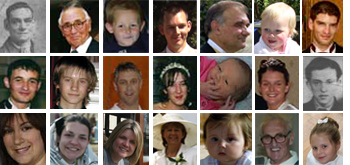| Origin
of surnames, generally
When we lived in small communities and travelled little,
circles of acquaintance were very limited and people were
known just by one name. As communities grew, and especially
where two people may have had the same name, it became necessary
to be a bit more specific, so a description would be added.
This might be a nickname (John the
Red head); it might relate to a trade (John
the Butcher), it could be an art, a place,
or a feature of the landscape where the person lived or just
about anything else that would distinguish one John from another.
These descriptive names were
not fixed or inherited. John's son might not have
a red head and might not be a butcher. He might
have been William (who lived
by the) River or William,
John's son.
Following the conquest of William in 1066,
the Normans imported from France the concept of more enduring
surnames. To begin with, some were still changed and even
dropped but after a while they became more or less permanent
and inherited. In this way nicknames, trades, places and so
on became surnames in the way we now know them.
This did not happen overnight. Surnames continued
to be formed in England well into the 15th century.
Wales did not adopt the surname system until the
countries were unified in 1536. |
Origin
and meaning of Titherly / Tytherleigh
Ours was one of the surnames that came from the place, which
in turn was named after a feature of the landscape. According
to the Dictionary of English Surnames (P. Rearny & R.
Wilson, 1997, Oxford University Press) the surname Titherly
appears to have come from the village of Tytherleigh in Chardstock,
Devon or Tytherley in Hampshire.
Old spellings of the name include Tederlea (1168)
and Tiderlega (1219). Tiderlega is old English
for 'young wood'. The word Tiderlega has two components.
The first seems to come from the old English 'tiedre'
meaning weak or fragile, and the second is 'leah'.
'Leah' probably comes in turn from the old Norse
'Lo' and the Latin 'Lucus'. Leah, Lo and Lucus
all mean 'grove' or 'thin wood', or more precisely
'an open place in a wood with the trees scattered
(naturally rather than cleared) in such a way
that grass can grow'.
The village of Tytherley, Hampshire, appears in documents
dating back to the Doomsday Book (late 11th century). Several
old maps of Hampshire show East Tytherley and West Tytherley,
to the west and slightly south of Winchester and close to
the boundary between Hampshire and Wiltshire (see below).
Tytherleigh, south of Chard, now in Devon, first
appeared in documents dating back to 1201. |
